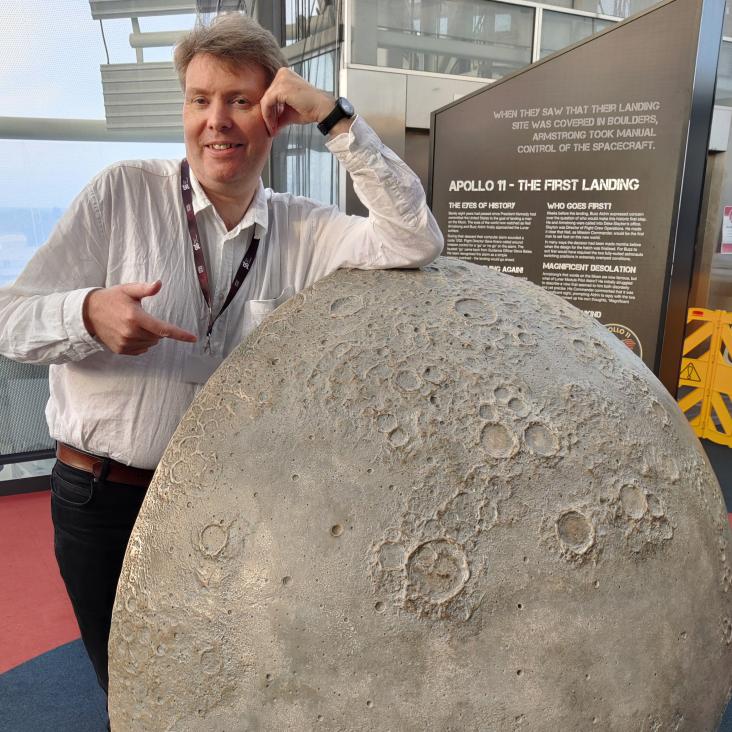Spectral Variability and Compositional Insights from Asteroid (101955) Bennu’s Sampling Sites Using OTES Data
(2025)
Authors:
Emma Belhadfa, Katherine Shirley, Neil Bowles
Abstract:
Introduction: During the Reconnaissance phase of NASA’s OSIRIS-REx mission, the Thermal Emission Spectrometer (OTES) acquired high–spatial resolution emissivity spectra over Bennu’s four prospective sampling sites [1, 2]. We analyse the calibrated OTES dataset archived in the Planetary Data System [3] to quantify compositional and mineralogical diversity across the original four candidate sample sites (Nightingale, Kingfisher, Osprey, and Sandpiper) and to explore possible drivers of Bennu’s surface heterogeneity, including implications for Bennu’s mineralogy and space-weathering history.
Figure 1: Site-Averaged Emissivity Spectra with Annotated Band Parameters
Methods: Calibrated emissivity spectra (5.7-100 µm) were linked to corresponding OCAMS imagery [5] to place the thermal infrared measurements in geological context, by cross-referencing observation times. For every spectrum we derived four diagnostic band parameters: Christiansen Feature (CF), silicate stretching band, silicate bending band and spectral slope, following the methods outlined in [6]. Each site contains thousands of spectral observations (site-averaged for visualization in Figure 1). The corresponding band parameters were compared using three statistical models: Principal Component Analysis (PCA) [5], k-Nearest Neighbors (KNN) [7], and Analysis of Variance (ANOVA) [8]. The three methods compare the mean and variance of each individual observation per site, considering how the in-group variance (i.e. the spread within all observations of a single site) compares to the out-group variance (i.e. the spread from other sites).
Results: Significant differences in emissivity spectra emerged among the four sites. PCA indicated that the first three components explain 85.5% of spectral variance, distinguishing Kingfisher as notably unique, with Sandpiper and Osprey exhibiting the greatest similarity. The KNN analysis corroborated PCA findings, reaching optimal classification accuracy (47%) at k = 21. ANOVA highlighted significant variability among the sites, especially in the spectral slope parameter (F = 762.8), suggesting differences in particle size distribution and space weathering could be driving factors in the detected heterogeneity [9]. Band ratio analyses provided additional insight into site-specific mineralogical distinctions, notably the relationship between silicate features and aqueous alteration indicators [10].
Figure 2: Distributions of Band Parameters by Site
Discussion: Variability in spectral parameters aligns with documented particle size frequency distributions and known space weathering spectral types across Bennu’s surface [9]. Nightingale, the mission’s selected sample site, captures representative global characteristics, contrasting with Kingfisher’s distinct compositional and physical attributes, potentially related to differences in Fe/Mg content and degree of aqueous alteration [10].
Conclusion: Integrative use of multiple statistical approaches confirms the compositional and physical diversity of Bennu's surface, as seen through the four prospective sites. These analyses provide a framework for interpreting returned sample data and offer insights into the connections between mineralogy, particle size, and space weathering processes on small airless body surfaces.
References: [1] Lauretta D. S. et al (2021) Sample Return Missions. [2] Hamilton V. et al. (2021) A&A (Vol. 650). [3] Christensen, P. R. et al. (2019) NASA Planetary Data System [4] Christensen P. R. et al. (2018) Space Science Reviews (Vol. 214, Issue 5). [5] Rizk B. et al (2018) Space Science Reviews (Vol. 214, Issue 1). [6] Xie B. et al (2022) Minerals (Vol. 508, Issue 12). [7] Kramer O. (2013) Intelligent Systems Reference Library (13-23). [8] Sawyer S. (2009) Journal of Manual & Manipulative Therapy. [9] Clark B. E. et al (2023) Icarus (Vol. 400). [10] Bates H. et al (2020) MaPS (Vol. 55, Issue 1).


